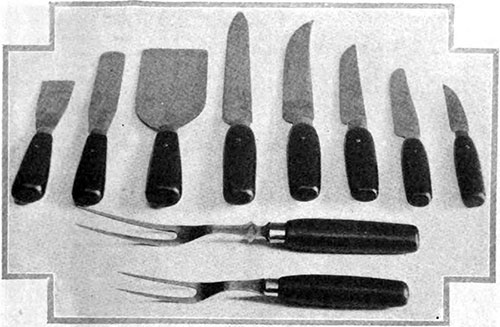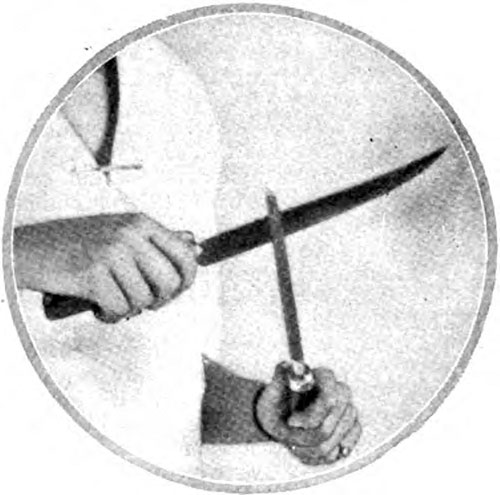Concerning Kitchen Cutlery - 1921

Each one is specially designed to play an important role
It is sad but true that few women are really successful in sharpening knives. Happily, there are exceptions to this rule, too. As a general thing the man in the family has kept the table carving knife in trim but has paid little attention to the unfortunate kitchen knives, and so they have been used and the housekeeper has '"made them do."
Sharpening a knife is simple enough—anybody can do it—but, of course, skill will come only through practice. The correct way to sharpen a knife is to hold the steel or whetstone firmly in the left hand, then holding the knife at a slight angle to the steel start at the top of the steel and draw the blade down from the handle end to the point, circumscribing a semicircle, allowing full play of the right wrist.
Alternate the stroke, first on the top of the steel and then underneath. Knives can be kept in much better condition if one person does the sharpening, because everybody holds the knife at a slightly different angle.
Metal surfaces are a menace to well sharpened knife blades. If your kitchen table has an enameled top, use a small, wooden cutting board. Some people object to storing knives in a drawer, but there is no objection to this unless the drawer is of metal, in which case it may be lined with blotting paper or felt, thus safeguarding the sharpened blades.
To keep the knives bright and shining, rub them frequently with one of the coarser friction soaps into which a large cork has been dipped. Better still is a cleaner now available made of hard rubber well impregnated with a friction powder. It not only cleans but produces a wonderful burnish.
Keep this close to your sink or in your sink cabinet, so that the knives can be brightened up each time they are washed. If this is made one of your unwritten rules, it will mean the saving of many minutes spent in renewing the badly stained knives.
Then, too, form the habit of rinsing off the knife immediately after cutting acid foods. Knives with stainless steel blades are now on the market and have been found satisfactory for kitchen knives as well as dinner knives, in which capacity they have been used for some time. Their more expensive first cost will be well repaid in the saving of time ordinarily spent in caring for them.
A complete set of well-made and well-kept knives has as much effect in producing efficiency in the kitchen and harmony in the household as any other piece of equipment.
Number of Specialty Knives has Increased
The paring, carving, and case knives used to be considered the extent of the kitchen knives, but the number has increased, not because we wish the cabinet drawer cluttered up with many kinds of knives, but because we need an efficient tool for each operation.
A cheap knife is a poor investment, for the reason that it will never hold an edge. Select knives with well-tempered steel blades. One-piece handles are most sanitary, and the stout ones are most comfortable.

The correct position for sharpening
At the top of the page are illustrated some knives and forks which fill almost every need in the kitchen. The paring knife at the extreme right is suited for general use, but many people prefer a shorter blade for some purposes, in which case it is advisable to have two such knives of different sizes.
The knife next to it is a modified case knife. The third is a general utility knife, so called because it is sturdy, rigid, and well pointed, and has the broadest use of any in the set.
There are carving knives both flexible and rigid. In general, hot meats and raw meats are rather soft and flabby, and for those you will need a stiff knife, which is specially pointed for cutting around bones. The sheer, with its long, flexible blade, is adapted for cold cuts of meat, cake, etc.
How many times have we ruined a cake, a meat loaf, or a baked fish simply because we were trying to move it with some narrow knife which could not support its entire weight? The broad spatula is the tool for this, and anything else which requires a broad flat surface. The long, narrow spatula becomes an invaluable tool for scraping mixing bowls.
The small knife at the extreme left of the illustration is similar to a painter's putty knife, having a stiff, blunt blade with one corner pointed and the other rounded. This knife is excellent for scraping.
The forks illustrated above are the best design for kitchen needs; namely, lifting and turning meats, testing vegetables, and so on. They have two tines and well-made rounded handles just like the knives.
These forks have no guard, but for that reason they become easier to keep clean. The guard is unnecessary and actually undesirable on a fork to be used for cooking, but it is a great protection on a carving fork.
Marion M . Mayer, “Concerning Kitchen Cutlery: Gleaned from the Institute's Experience,” in Good Housekeeping, New York: International Magazine Company, Vol. LXXII, No. 1, January 1921, p. 51.
